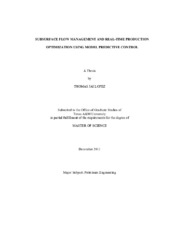| dc.description.abstract | One of the key challenges in the Oil & Gas industry is to best manage reservoirs under different conditions, constrained by production rates based on various economic scenarios, in order to meet energy demands and maximize profit. To address the energy demand challenges, a transformation in the paradigm of the utilization of "real-time" data has to be brought to bear, as one changes from a static decision making to a dynamical and data-driven management of production in conjunction with real-time risk assessment. The use of modern methods of computational modeling and simulation may be the only means to account for the two major tasks involved in this paradigm shift: (1) large-scale computations; and (2) efficient utilization of the deluge of data streams.
Recently, history matching and optimization were brought together in the oil industry into an integrated and more structured approach called optimal closed-loop reservoir management. Closed-loop control algorithms have already been applied extensively in other engineering fields, including aerospace, mechanical, electrical and chemical engineering. However, their applications to porous media flow, such as - in the current practices and improvements in oil and gas recovery, in aquifer management, in bio-landfill optimization, and in CO2 sequestration have been minimal due to the large-scale nature of existing problems that generate complex models for controller design and real-time implementation. Their applicability to a realistic field is also an open topic because of the large-scale nature of existing problems that generate complex models for controller design and real-time implementation, hindering its applicability.
Basically, three sources of high-dimensionality can be identified from the underlying reservoir models: size of parameter space, size of state space, and the number of scenarios or realizations necessary to account for uncertainty. In this paper we will address type problem of high dimensionality by focusing on the mitigation of the size of the state-space models by means of model-order reduction techniques in a systems framework. We will show how one can obtain accurate reduced order models which are amenable to fast implementations in the closed-loop framework .The research will focus on System Identification (System-ID) (Jansen, 2009) and Model Predictive Control (MPC) (Gildin, 2008) to serve this purpose.
A mathematical treatment of System-ID and MPC as applied to reservoir simulation will be presented. Linear MPC would be studied on two specific reservoir models after generating low-order reservoir models using System-ID methods. All the comparisons are provided from a set of realistic simulations using the commercial reservoir simulator called Eclipse. With the improvements in oil recovery and reductions in water production effectively for both the cases that were considered, we could reinforce our stance in proposing the implementation of MPC and System-ID towards the ultimate goal of "real-time" production optimization. | en |


